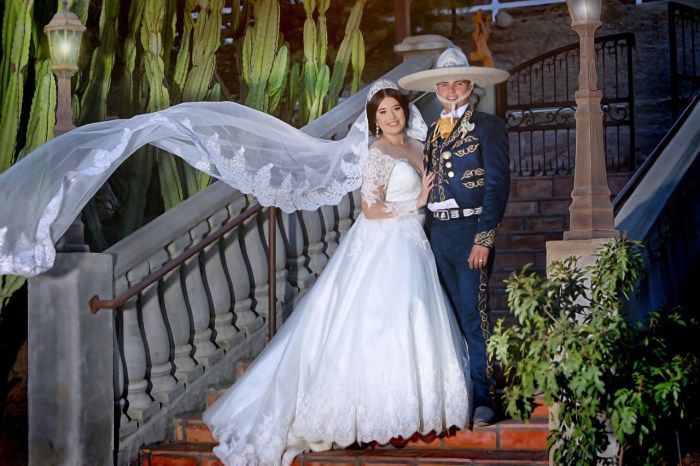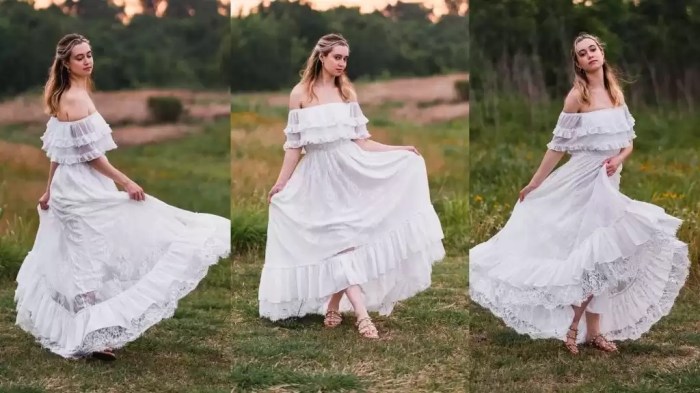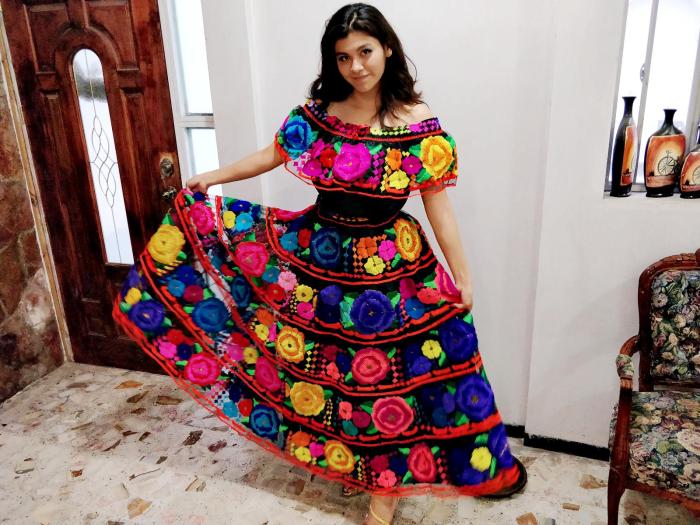Regional Variations in Traditional Mexican Wedding Dresses: Mexico Traditional Wedding Dress
Mexico traditional wedding dress – Mexico’s diverse geography and cultural heritage are beautifully reflected in the stunning array of traditional wedding dresses found across its various regions. From the vibrant hues of Oaxaca to the intricate embroidery of Chiapas, each region boasts unique styles, fabrics, and embellishments that tell a story of local traditions and historical influences.
Regional Dress Styles
The following table highlights the distinct characteristics of wedding dresses from several key Mexican regions:
| Region | Dress Style Characteristics | Common Fabrics | Notable Embellishments |
|---|---|---|---|
| Oaxaca | Often features a huipil (a traditional blouse) paired with a skirt, showcasing intricate embroidery and vibrant colors. The style can vary significantly between communities within Oaxaca. | Cotton, silk, wool | Elaborate embroidery depicting flora, fauna, and symbolic motifs; often includes hand-stitched details. |
| Yucatán | Characterized by simpler, more flowing silhouettes, often featuring delicate lace and pastel colors. The influence of Mayan culture is evident in some designs. | Cotton, linen, lace | Guipure lace, delicate embroidery, often incorporating elements inspired by Mayan iconography. |
| Chiapas | Known for its richly embroidered huipiles, often incorporating bold geometric patterns and deep, rich colors. The designs often reflect the region’s indigenous heritage. | Cotton, silk | Intricate embroidery using vibrant threads; designs often tell stories or represent community identity. |
| Jalisco | Frequently incorporates a long, flowing skirt with a fitted bodice, often adorned with lace or delicate embroidery. The style is often more formal and elegant. | Silk, satin, lace | Lace appliqués, delicate beading, satin ribbons. |
Color and Symbolism in Regional Dresses

Source: strutbridalsalon.com
Color plays a significant role in Mexican wedding attire. While white is increasingly common, many regions maintain traditions that incorporate vibrant hues. For example, in Oaxaca, bright reds and greens often symbolize fertility and prosperity, while in Yucatán, softer pastels may represent purity and grace. Specific patterns and motifs also carry symbolic meaning, often reflecting the couple’s hopes for a blessed and fruitful marriage.
Historical Influences on Regional Styles
The unique characteristics of regional wedding dresses are shaped by a complex interplay of indigenous traditions, Spanish colonial influences, and later global trends. Indigenous textiles and embroidery techniques remain central to many designs, while Spanish colonial styles introduced elements like lace and more structured silhouettes. The fusion of these influences created the rich tapestry of regional variations we see today.
The Significance of Fabrics and Embellishments
The fabrics and embellishments used in traditional Mexican wedding dresses are not merely decorative; they carry deep cultural significance, often representing family heritage, community identity, and the couple’s hopes for the future.
Traditional Fabrics and Their Cultural Significance
Several traditional fabrics hold particular importance. Silk, often associated with luxury and refinement, might be used in more formal dresses. Cotton, a more readily available and practical fabric, is common in many regional styles, reflecting the practicality of everyday life. Brocade, with its intricate woven patterns, adds a touch of elegance and sophistication.
Common Embellishments and Their Symbolic Meaning, Mexico traditional wedding dress

Source: apxv.org
Embroidery is a ubiquitous feature, often depicting floral motifs, geometric patterns, or scenes from daily life. These designs are not merely decorative; they frequently tell stories or symbolize important cultural beliefs. Lace, often imported during the colonial era, adds a touch of European elegance, while beading can introduce elements of sparkle and celebration.
Intricate Embellishment Detail: Oaxacan Embroidery
Consider the intricate embroidery found on many Oaxacan wedding dresses. Tiny stitches, often worked in vibrant threads, create dense patterns of flowers, animals, and symbolic motifs. Each stitch represents hours of painstaking work, embodying the dedication and commitment the couple pledges to each other. The vibrant colors themselves symbolize fertility, prosperity, and the vibrancy of life.
Evolution of the Traditional Mexican Wedding Dress
The Mexican wedding dress has undergone a fascinating evolution, reflecting broader social, economic, and cultural changes over time. Key periods and events have profoundly influenced its design and style.
Historical Evolution of the Dress
- Pre-Hispanic Era: Indigenous traditions emphasized simple, functional garments often made from natural fibers, reflecting the daily life and environment of the time.
- Colonial Period (16th-18th centuries): Spanish influence introduced European styles, including lace, structured bodices, and richer fabrics. A fusion of indigenous and Spanish elements began to emerge.
- 19th and early 20th centuries: European fashion trends continued to influence Mexican wedding attire, with variations reflecting regional preferences and access to materials.
- Mid-20th century to present: The rise of mass production and globalization led to a wider range of styles and fabrics. However, many regions continue to uphold traditional styles, adapting them to contemporary tastes.
Modern Interpretations of Traditional Styles
Contemporary Mexican designers are increasingly incorporating traditional elements into modern wedding dress designs. This includes using traditional fabrics, embroidery techniques, and color palettes in innovative ways, creating unique and stylish gowns that honor the country’s rich heritage.
The Role of the Wedding Dress in Mexican Wedding Ceremonies
The wedding dress plays a central role in traditional Mexican wedding ceremonies, extending beyond mere attire to become a powerful symbol of the couple’s union and their cultural identity.
Significance of the Dress in the Ceremony
The dress is often a focal point throughout the ceremony. It signifies the bride’s transition into married life, representing her commitment and her connection to her family and cultural heritage. The intricate details of the dress, such as the embroidery or lace, can also be seen as symbolic representations of the couple’s hopes for a long and prosperous life together.
The Dress’s Role in Ceremony Stages

Source: redd.it
From the pre-wedding preparations to the reception, the dress acts as a visual anchor, signifying the importance of the occasion. The dress is often carefully chosen to reflect the bride’s personal style while honoring family traditions, making it a key component in the overall celebration.
Modern Interpretations and Influences
Contemporary Mexican wedding fashion showcases a dynamic interplay between tradition and innovation. Modern designers are creatively reinterpreting traditional elements to create unique and stylish gowns.
Traditional vs. Contemporary Wedding Dress Elements
| Traditional Element | Modern Adaptation | Impact on Overall Design | Cultural Significance |
|---|---|---|---|
| Intricate Embroidery | Embroidered details incorporated into a modern silhouette, perhaps on the bodice or sleeves. | Adds a touch of traditional elegance to a contemporary design. | Preserves the cultural heritage while embracing modern aesthetics. |
| Vibrant Colors | Use of bold colors as accents, such as a brightly colored sash or underskirt. | Adds a pop of color and personality to a more neutral base. | Retains the vibrancy and symbolism of traditional colors. |
| Traditional Fabrics | Incorporation of traditional fabrics like silk or cotton in a modern cut and design. | Provides a luxurious texture and feel, while maintaining the cultural connection. | Honors the legacy of traditional materials and craftsmanship. |
Modern Influences on Mexican Wedding Dresses
Modern influences include the adoption of international design trends, the use of new fabrics and technologies, and the growing emphasis on individuality and personal expression. These influences have led to a diverse range of contemporary Mexican wedding dresses, each with its own unique style and personality.
Hypothetical Modern Mexican Wedding Dress
Imagine a flowing A-line gown in a soft ivory silk. The bodice features delicate, hand-embroidered floral motifs inspired by traditional Oaxacan designs, while the skirt cascades gracefully to the floor. A vibrant red sash, a nod to traditional symbolism, cinches the waist, adding a pop of color and personality. The overall effect is a stunning blend of classic elegance and rich cultural heritage, showcasing the best of both worlds.
FAQ
What is the average cost of a traditional Mexican wedding dress?
The cost varies greatly depending on the region, intricacy of the design, and the materials used. Prices can range from a few hundred to several thousand dollars.
Where can I find a traditional Mexican wedding dress?
Depending on the region you are interested in, you may find artisans or boutiques specializing in traditional Mexican clothing. Online marketplaces may also offer options, but careful research is advised to ensure authenticity.
Are there specific rules or customs surrounding wearing a traditional Mexican wedding dress?
The vibrant hues and intricate embroidery of a traditional Mexican wedding dress are truly captivating. Choosing an outfit for a wedding, especially one with a more relaxed atmosphere, requires careful consideration; if the wedding is a backyard affair, you might find inspiration for a suitable guest dress at backyard wedding guest dress websites. Returning to the Mexican wedding dress, the style often reflects regional variations, showcasing the rich cultural heritage of Mexico.
Customs vary by region and family. Some families may have specific traditions regarding the dress, while others are more flexible. It’s best to consult with family members or a wedding planner familiar with local customs.
How long does it typically take to create a handcrafted traditional Mexican wedding dress?
The time required varies greatly depending on the complexity of the design and embellishments. It can range from several weeks to several months.
